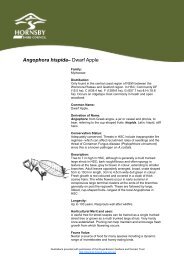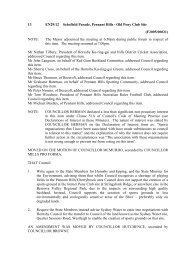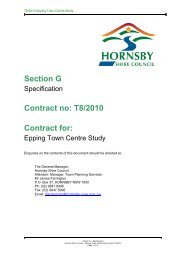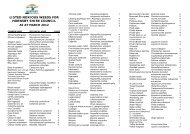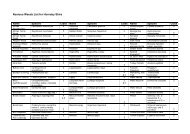Grasses and Sedges - Hornsby Shire Council
Grasses and Sedges - Hornsby Shire Council
Grasses and Sedges - Hornsby Shire Council
Create successful ePaper yourself
Turn your PDF publications into a flip-book with our unique Google optimized e-Paper software.
GRASSES<br />
& SEDGES<br />
A plant that usually consists of a tuft of<br />
leaves arising from a stem that elongates<br />
at flowering time<br />
Sedge: A grass-like plant with a triangular<br />
stem often growing in wet areas.
BASKET GRASS <strong>and</strong> TAHITIAN BRIDAL VEIL<br />
NATIVE: Basket Grass (Oplismenus<br />
imbecillis/ aemulus) is a creeping grass in<br />
the Poaceae family that is found in the<br />
Eastern <strong>and</strong> Northern States of Australia.<br />
It has low growing sprawling stems, with<br />
1cm wide leaves. It grows in moist areas<br />
to shady areas <strong>and</strong> can sometimes be<br />
found in full shade. The leaves have wavy<br />
margins <strong>and</strong> fine hairs. The two species<br />
differ as O.imbecillis has more slender<br />
leaves. The small red flowers appear in<br />
summer to Autumn on short erect stems.<br />
This grass is very hardy <strong>and</strong> has an<br />
ornamental quality about it. It makes a<br />
great native lawn that can look very neat<br />
when mowed.<br />
WEED: Tahitian Bridal Veil (Tradescantia<br />
multiflora) is a ground herb in the family<br />
Commelinaceae. This herb has tiny leaves<br />
<strong>and</strong> wiry stems. It looks <strong>and</strong> grows very<br />
much like a smaller version of the native<br />
Commelina. This weed is more a garden<br />
escape as it is mostly planted in gardens or<br />
used in hanging pots. It has small white<br />
flowers, which produce a fine “veil”. Tahitian<br />
Bridal Veil is hairless, <strong>and</strong> has shiny leaves.<br />
While this plant is not “invasive” it can be<br />
mistaken for a native. Other species which<br />
are very similar are Gibasis geniculata <strong>and</strong><br />
Gibasis pellucida.<br />
WEED REMOVAL<br />
Tahitian Bridal Veil can be removed by h<strong>and</strong>. Nodes left in the ground will resprout,<br />
but careful attention while weeding could soon remove this semi invasive<br />
plant.<br />
24
HEDGEHOG GRASS <strong>and</strong> PIGEON GRASS<br />
WEED: Pigeon grass (Setaria sp.) is an annual or perennial<br />
grass also in the Poaceae Family.<br />
This grass can be found in disturbed sunny positions, along<br />
roadsides <strong>and</strong> along disturbed bushl<strong>and</strong> edges. The leaf<br />
blade is often rolled or folded, <strong>and</strong> the leaf base can often<br />
be red. Sometimes this leaf base will break off where it<br />
meets the roots. This plant can also spread via rhizomes,<br />
in this form it can often dieback in winter. The flower is a<br />
terminal panicle which is narrow, dense <strong>and</strong> spike like to<br />
around 3-5cm in length. Setaria grasses are characterised<br />
by their stiff bristled seed head. Pigeon grass has quite<br />
large rounded seed that will drop off <strong>and</strong> the bristles remain.<br />
The seed on pigeon grass ripen late Spring to Summer.<br />
This grass is spread by wind, mud, animals <strong>and</strong> in feed. It<br />
germinates very easily, so needs careful treatment.<br />
NATIVE: Hedgehog grass, Echinopogon<br />
ovatus is a native grass in the Poaceae<br />
family. It grows on rich soils in sunny or<br />
shady positions. The grass is<br />
distinguishable by the small ovoid shaped<br />
seed head, looking like a small brush.<br />
When it is not in seed though, the grass is<br />
fairly easily identified at 60-100 cm tall,<br />
tufted with curled leaves around the base.<br />
The leaves are bright green <strong>and</strong> slightly<br />
hairy, short <strong>and</strong> membranous. The grass<br />
is rough when touched with a downward<br />
action <strong>and</strong> feels like it is sticking to you.<br />
The seed head is 5mm long <strong>and</strong> ovate<br />
<strong>and</strong> seed spreads via attachment to fur or<br />
clothing.<br />
WEED REMOVAL<br />
Pigeon grass can be removed by h<strong>and</strong> weeding using<br />
crowning to ensure the removal of the whole plant. This should be<br />
done before the plant seeds (before spring). Unfortunately it is also an important food<br />
source for a variety of birds including quails, lapwings, choughs, scrub-wrens <strong>and</strong><br />
finches.<br />
25
BARBED WIRE GRASS <strong>and</strong> WHISKY GRASS<br />
NATIVE: Barbed-wire grass Cymbopogon<br />
refractus is a tufted grass with tall wiry<br />
stems. It can be found in woodl<strong>and</strong> areas<br />
on s<strong>and</strong>stone <strong>and</strong> other rocky areas. This<br />
grass is found in most parts of NSW, Qld,<br />
Vic <strong>and</strong> NT. Its inflorescence (shown left)<br />
resembles the barbs of barbed-wire. This<br />
is due to the racemes which point<br />
downwards on maturity. It also has an<br />
aromatic smell when<br />
crushed <strong>and</strong> it is<br />
Themeda<br />
interesting to know that<br />
the commonly used<br />
cooking herb, Lemon<br />
Grass Cymbopogon<br />
citrinus <strong>and</strong> other<br />
Cymbopogons have a<br />
lemon scent to them.<br />
WEED: Whisky Grass or Andropogon virginicus is a weed grass that is native to America.<br />
Whisky grass is seen to invade very open sunny areas, roadsides, fire-trails, fields <strong>and</strong><br />
other disturbed areas. It is common to Hawkesbury s<strong>and</strong>stone <strong>and</strong> other low nutrient soils.<br />
Whisky grass can be very invasive, <strong>and</strong> produces wind<br />
dispersed seed which can lie dormant in the soil<br />
throughout the winter. Whisky Grass can also look like<br />
the native Kangaroo grass Themeda australis (pictured<br />
above)<br />
WEED REMOVAL<br />
The weed Whisky Grass can be removed by<br />
crowning but it is important to remove this grass<br />
before it sets seed in spring. If the grass has fluffy<br />
seed in the tops these should be cut off, placed in<br />
bags <strong>and</strong> disposed.<br />
26
POA AFFINIS <strong>and</strong> AFRICAN LOVE GRASS<br />
NATIVE: Poa affinis is a native grass<br />
found in Sydney <strong>and</strong> in the Blue<br />
Mountains. It grows in the understorey of<br />
woodl<strong>and</strong>s <strong>and</strong> forests primarily on<br />
s<strong>and</strong>stone soils. Poa affinis is<br />
widespread in the <strong>Hornsby</strong> district. This<br />
grass is loosely tufted with branched<br />
stems. It has soft light green leaves <strong>and</strong><br />
a small blunt <strong>and</strong> membranous ligule.<br />
The inflorescence of Poa is a spreading<br />
open seed head with blue green<br />
spikelets made up of 2-4 florets. Poa<br />
flowers in late spring <strong>and</strong> can range from<br />
60 to 1.2m in height.<br />
WEED: African Lovegrass, Eragrostis<br />
curvula is a weed from South Africa. It is<br />
a robust, densely tufted perennial grass<br />
that grows particularly well along<br />
roadsides, railways, riverbanks <strong>and</strong><br />
wastel<strong>and</strong>s. It is very invasive <strong>and</strong> is<br />
also very hardy, growing from 1-2m in<br />
height. The stems are long with green to<br />
blue leaf blades. These are rough to<br />
touch <strong>and</strong> often arch <strong>and</strong> curl up to the<br />
tip (hence “curvula”). The ligule has an<br />
inconspicuous ring of hairs enclosed by<br />
auricles (collar). The flower is quite<br />
similar to the Poa, but the Lovegrass<br />
has a dark olive-green spikelet<br />
consisting of 3-18 florets. Seeds are<br />
often subject to a black rust, unlike Poa.<br />
WEED REMOVAL<br />
African Lovegrass can be h<strong>and</strong> pulled when young, but as it has a matted root<br />
system often a mattock or lever should be used. Spraying with 1:100 glyphosate<br />
can also be used with varying results. As the native <strong>and</strong> weed look so similar,<br />
check for the spikelet colour <strong>and</strong> the distinctive curling of leaf blades on the weed.<br />
27
WEEPING MEADOW GRASS <strong>and</strong> PANIC VELDTGRASS<br />
NATIVE: Weeping Meadow grass (Microlaena stipoides)<br />
grows widespread on s<strong>and</strong>stone <strong>and</strong> clay soils across<br />
Australia except N.T. It is a slender erect grass 15-70 cm<br />
high with a variety of forms but all with the same distinctive<br />
weeping seed head. Each seed has a spike attached to it<br />
that helps its distribution by getting caught on socks,<br />
clothes, fur <strong>and</strong> feathers of all moving creatures. This grass<br />
often has a bluish green tinge to its leaves which are short,<br />
flat <strong>and</strong> thin growing from tufts. The leaves can be smooth or<br />
sometimes hairy <strong>and</strong> the leaf tip has a small indent which is<br />
a good indication that it is the native! Microlaena can also<br />
form clumped runners that are easily seen if it is accidentally<br />
pulled out.<br />
SEED HEADS:<br />
Microlaena (left) <strong>and</strong><br />
Ehrharta (right) have<br />
very different seed heads. The<br />
inset (far left) shows the<br />
Microlaena seed.<br />
WEED: Panic Veldtgrass often known as Ehrharta (pronounced airheart-a)<br />
(Ehrharta erecta) is originally from South Africa <strong>and</strong> is a<br />
widespread weed. It tends to grow in sunny positions particularly in<br />
disturbed zones <strong>and</strong> can grow up to 60cm, although usually<br />
remains about 30cm tall. It spreads out from the root base allowing<br />
the seed heads to colonise new soil. It has much brighter green<br />
leaves bordering on a green yellow in some situations. The leaves<br />
are generally wider than Microlaena <strong>and</strong> at the margin between the<br />
leaf sheath <strong>and</strong> the leaf blade there is a ligule (bit that sticks out),<br />
which is not present in Microlaena. Its seed head is more erect than<br />
Microlaena <strong>and</strong> has no form of seed attachment.<br />
WEED REMOVAL<br />
Ehrharta can be removed by h<strong>and</strong> or sprayed with 1:100<br />
glyphosate. It is important to try to prevent it from seeding as<br />
it seeds prolifically <strong>and</strong> often especially in exposed areas.<br />
When removing Ehrharta that is seeding remember to bag it<br />
for disposal or compost it.<br />
28
SPINY HEADED MAT RUSH <strong>and</strong> WILD IRIS<br />
NATIVE: Mat Rush (Lom<strong>and</strong>ra longifolia) is a grass-like herb in the<br />
Lom<strong>and</strong>raceae family. It grows as a tufted herb with wide strap like leaves<br />
usually around 50 cm long. It is fairly common <strong>and</strong> grows in a wide range of<br />
habitats. Its flower spike is a prickly branched inflorescence. Its seeds are like<br />
wheat grains <strong>and</strong> easy to propagate. A distinguishing feature, other than its strap<br />
like leaves, are its leaf tip. This has a prominent tooth or serration that is<br />
common to many Lom<strong>and</strong>ra species. Lom<strong>and</strong>ra is<br />
commonly used in roadside plantings around<br />
Sydney.<br />
WEED: The Wild Iris (Dietes gr<strong>and</strong>iflora) is often<br />
confused with Lom<strong>and</strong>ra due to its long strappy leaves of<br />
the same length. It also grows as a tufted herb, but is<br />
actually from South Africa, <strong>and</strong> is in the Iridaceae family.<br />
This is not a very invasive plant <strong>and</strong> it most commonly<br />
has beautiful iris like flowers of white petals with purple<br />
<strong>and</strong> orange markings. Its seed head is very different to<br />
the Mat Rush (pictured). The leaves are more shiny <strong>and</strong><br />
slightly thinner to the Lom<strong>and</strong>ra with a pointed tip on it<br />
with no serration. Other forms of Dietes have different<br />
colour flowers such as the yellow (shown) <strong>and</strong> blue.<br />
WEED REMOVAL<br />
The Dietes is fairly easy to remove. Pull out any<br />
smaller Dietes by h<strong>and</strong> (check the tip if unsure…no<br />
tooth, flat base <strong>and</strong> it is the weed) <strong>and</strong> any larger<br />
clumps can be dug out with a mattock. If this weed is<br />
not spreading vigorously <strong>and</strong> is providing habitat for<br />
small birds or lizards alternative control might be to<br />
simply collect <strong>and</strong> bag its seed head after it flowers.<br />
29
BARBED WIRE GRASS <strong>and</strong> COOLATAI GRASS<br />
NATIVE: Barbed-wire grass<br />
Cymbopogon refractus is a tufted<br />
grass with tall wiry stems. It can be<br />
found in woodl<strong>and</strong> areas on<br />
s<strong>and</strong>stone <strong>and</strong> other rocky areas.<br />
This grass is found in most parts of<br />
NSW, Qld, Vic <strong>and</strong> NT. Its<br />
inflorescence (shown left)<br />
resembles the barbs of barbedwire.<br />
This is due to the racemes<br />
which point downwards on<br />
maturity. It also has an aromatic<br />
smell when crushed <strong>and</strong> it is<br />
interesting to know that the<br />
commonly used cooking herb,<br />
Lemon Grass Cymbopogon<br />
citrinus <strong>and</strong> other Cymbopogons<br />
have a lemon scent to them.<br />
WEED: Coolatai Grass or Hyparrhenia hirta is a<br />
weed grass from Africa <strong>and</strong> the Mediterranean.<br />
It is a weed that can be found in <strong>Hornsby</strong> <strong>Shire</strong>,<br />
along the northern NSW coast <strong>and</strong> Western<br />
Australia <strong>and</strong> grows along roadsides <strong>and</strong> in<br />
pastures. Also known as Tambookie Grass, this<br />
weed grows to 120cm tall <strong>and</strong> has tall seed<br />
heads with long spikelets (2-4mm) that are a<br />
rusty brown colour. It is very difficult to<br />
distinguish from the native grass except that it<br />
has no distinct smell when crushed <strong>and</strong> the<br />
spikelets are often paired.<br />
WEED REMOVAL<br />
Coolatai Grass can be h<strong>and</strong> removed using a mattock.<br />
Ensure all seed heads are bagged <strong>and</strong> disposed.<br />
30
SAW SEDGE <strong>and</strong> PAMPAS GRASS<br />
NATIVE: The Saw Sedge (Gahnia sp.) is a native sedge found in a wide range of areas.<br />
Some species grow on creek edges, in swamp<br />
pockets of forests <strong>and</strong> some prefer salty soils.<br />
This genus is in the Cyperaceae family <strong>and</strong><br />
grows to 2.5 metres with high flowering spikes<br />
that produce small nuts (1.5-5.5mm) which are<br />
red/ brown. It flowers between spring <strong>and</strong><br />
summer, but the flowers are insignificant. The<br />
leaves are glossy green, linear to<br />
drooping <strong>and</strong> have small serrations<br />
along them as described in their name.<br />
The Gahnias can often be confused<br />
with Pampas Grass, however some<br />
noticeable differences set them apart.<br />
WEED: Pampas Grass (Cortaderia selloana) is in<br />
the Poaceae (grass) Family <strong>and</strong> was introduced as<br />
a garden plant from South America. It is a dense<br />
tussocky perennial grass that can grow up to 3<br />
metres. It has a flower spike up to 4 m high. This<br />
flower spike has a large silky plume up to one<br />
metre long, which flowers in summer <strong>and</strong> produces<br />
loads of seed. Also the leaves, like the Gahnia,<br />
have silica serrations which are bluish green in<br />
colour. Often the leaves die off <strong>and</strong> curl around the<br />
base looking like wood shavings. The Pampas is<br />
often found in drainage lines, waste areas <strong>and</strong><br />
disturbed zones. It is at present considered a<br />
noxious weed due to its size <strong>and</strong> rapid distribution<br />
through natural areas.<br />
Picture by Paul Marynissen.<br />
WEED REMOVAL<br />
Pampas Grass can be h<strong>and</strong> pulled as a seedling but as an adult, especially over 3m tall,<br />
requires other removal methods. It can be sprayed (although it can reshoot), or cut at<br />
the base <strong>and</strong> the base sprayed with 1:100 glyphosate. All seed heads should be<br />
removed <strong>and</strong> bagged for disposal. Safety must also be considered when removing this<br />
weed. The silica in the serrated edges can cut deep: gloves <strong>and</strong> goggles must be worn<br />
for protection. Long sleeves <strong>and</strong> long trousers are also highly recommended. When<br />
cutting pampas, the silica can form a dust. A dust mask is useful to protect from<br />
inhalation <strong>and</strong> accidental ingestion.<br />
31
BLUE FLAX LILY <strong>and</strong> SPIDER PLANT<br />
NATIVE: The Blue Flax Lily (Dianella<br />
caerulea) is a native tufted herb to 50 cm tall<br />
in the Liliaceae family found in woodl<strong>and</strong><br />
<strong>and</strong> s<strong>and</strong>stone plant communities. It prefers<br />
fertile soils in well shaded areas. This native<br />
lily has dark green strapped leaves which<br />
have small serrations up each edge (see<br />
inset).These can be felt more than seen.<br />
The leaves are sheathed at the base <strong>and</strong><br />
attached to a small stalk. Dianella flowers in<br />
spring <strong>and</strong> has a long flower spike with<br />
small blue flowers which turn into purpleblue<br />
berries. These are edible when ripe<br />
(purple). The flowers <strong>and</strong> fruit are also often<br />
deformed by thrips. Flower scans: Jenifer Lewis,<br />
<strong>Hornsby</strong> Online Herbarium:<br />
WEED: Spider Plant (Chlorophytum<br />
comosum) is a weed from South Africa which<br />
is also in the Liliaceae family. It can grow in a<br />
variety of conditions <strong>and</strong> spreads by seed <strong>and</strong><br />
by vegetative parts. It flowers in summer <strong>and</strong><br />
has small white flowers on its stalks <strong>and</strong><br />
produces an angular seed capsule. Some<br />
varieties of Spider Plant are variegated (have<br />
white stripes up the leaves) or have pale<br />
green leaves. The leaves are thick <strong>and</strong> the<br />
roots are bulbous <strong>and</strong> used to store water. It<br />
has no serrations on its leaf edge, <strong>and</strong> the<br />
leaves can often elongate to produce a new<br />
plant from the tip (plantlet) that will root <strong>and</strong><br />
detach from the original adult plant.<br />
WEED REMOVAL<br />
The weed Spider Plant can be dug out with a mattock <strong>and</strong> left to dry out. Also be aware<br />
that after removal, especially of a large patch, dense germination of the weed can occur.<br />
32
SPINY HEADED MAT RUSH <strong>and</strong> LOMANDRA<br />
HYSTRIX<br />
NATIVE: The Spiny Headed Mat-Rush or Lom<strong>and</strong>ra<br />
longifolia, a native Lom<strong>and</strong>ra to the <strong>Hornsby</strong> area grows<br />
from 50-100cm tall. It has 5-7.5mm wide leaf blades, which<br />
are distinguishable by their hairless, conspicuous marginal<br />
sclerenchyma b<strong>and</strong>s. The inflorescence of L.longifolia<br />
st<strong>and</strong>s shorter than the leaf blades reaching maximum<br />
15cm long. The flower clusters are whorled up the<br />
inflorescence <strong>and</strong> appear yellow or cream. The<br />
inflorescence is multi branched, truncate <strong>and</strong> clustered.<br />
Lom<strong>and</strong>ra have male <strong>and</strong> female plants distinguished by<br />
their flowers. The male flowers are shorter at 3.5mm,<br />
where the female are around 4.5mm long (see picture).<br />
The leaf apex or tip of this native is 2 or 3 toothed, with<br />
the central tooth pronounced. There are a few different<br />
forms of the teeth (shown) <strong>and</strong><br />
these are generally orange<br />
brown or reddish brown. Lom<strong>and</strong>ra<br />
longifolia flowers in spring only.<br />
Lom<strong>and</strong>ra longifolia has relatively thick<br />
leaf blades, <strong>and</strong> aborigines used them to<br />
weave baskets. The white base of the<br />
leaf was also eaten.<br />
WEED: Lom<strong>and</strong>ra hystrix is native to Australia, but only found<br />
north from Taree into Queensl<strong>and</strong>. This plant has made its way<br />
into more Southern areas due to the commercialisation as a<br />
hardy garden plant. L.hystrix grows from 90 to 150cm tall. The<br />
leaf blades are quite thin, a brighter green, flat <strong>and</strong> wide with a<br />
toothed tip. The tooth is acutely pointed <strong>and</strong> mostly white in<br />
colour (occasionally brown to reddish brown). The male <strong>and</strong><br />
female flowers are very similar <strong>and</strong> both inflorescences will<br />
grow as tall as the leaf blades. The inflorescence is branched<br />
only twice <strong>and</strong> is flattened with whorled flower clusters. Male<br />
<strong>and</strong> female flower sizes are the same as Lom<strong>and</strong>ra longifolia<br />
<strong>and</strong> are also yellow or cream. L.hystrix flowers in spring <strong>and</strong><br />
summer. The leaves lack conspicuous sclerenchyma marginal<br />
b<strong>and</strong>s on the leaves, <strong>and</strong> have a different tip shape. Lom<strong>and</strong>ra<br />
hystrix does not seed as readily as Lom<strong>and</strong>ra longifolia.<br />
WEED REMOVAL<br />
The weed Lom<strong>and</strong>ra can be removed by h<strong>and</strong> pulling when young or by<br />
mattocking out when large.<br />
33
SEA RUSH <strong>and</strong> SPINY RUSH<br />
NATIVE: The native sedge Sea Rush (Juncus kraussii) is in the Family Juncaceae <strong>and</strong><br />
is found growing in brackish waters/ coastal areas. It looks similar to the Common Rush<br />
(Juncus usitatus) that grows in creeklines <strong>and</strong> fresh water/moist areas.<br />
WEED: Juncus acutus is a weed<br />
originating from Europe, Africa <strong>and</strong> North<br />
America, as the name suggests is a very<br />
spiky sedge that also grows along brackish<br />
or coastal areas, <strong>and</strong> is easily distinguished<br />
by its extremely sharp spiny leaf tips.<br />
Also in the Family Juncaceae, Spiny rush<br />
has a characteristic globe shape to it, <strong>and</strong><br />
can grow up to 1.6 m tall. It has invaded<br />
many significant wetl<strong>and</strong>/salt marsh areas,<br />
<strong>and</strong> is particularly difficult to remove,<br />
because of its spiny nature, <strong>and</strong> the<br />
locations it inhabits.<br />
The Sea Rush has more open<br />
stems, <strong>and</strong> often appears<br />
brown due to the dying leaves<br />
within its tufts. It grows<br />
between 50-100 cm tall, <strong>and</strong><br />
has a tall <strong>and</strong> open<br />
appearance.<br />
WEED REMOVAL<br />
Juncus acutus is a difficult weed to control, it can be h<strong>and</strong> mattocked out, but<br />
great care should be taken to avoid injury from the spiny tips. This is also time<br />
consuming, <strong>and</strong> alternative removal can be slashing <strong>and</strong> then respraying new<br />
growth (when tides are low to avoid water contamination). It is preferable to spray<br />
with Glyphosate during warmer months.<br />
34
SALTWATER COUCH <strong>and</strong> COMMON COUCH<br />
often are found quite deep in the soil,<br />
so is difficult to remove simply by<br />
h<strong>and</strong>, without a lot of disturbance to<br />
other natives or the soil itself.<br />
Common Couch has an awned seed<br />
head, <strong>and</strong> the leaves are a lot shorter<br />
than the Saltwater Couch. Common<br />
Couch grows readily from seed <strong>and</strong><br />
runners/dumped plant parts, as it roots<br />
readily from the stems.<br />
Photos : www.thebegavalley.org.au<br />
NATIVE: In the Family Poaceae, the Saltwater couch<br />
(pronounced “kooch”) Sporobolous virginicus, is a<br />
native creeping grass that grows in coastal areas, often<br />
in thickets. It spreads using underground runners <strong>and</strong><br />
by seed. The leaves are erect <strong>and</strong> greyish green in<br />
colour. The grass blades can reach up to 50 cm tall <strong>and</strong><br />
it often grows in s<strong>and</strong>y soils.<br />
This grass is a perennial, <strong>and</strong> is often confused with the<br />
Common Couch<br />
WEED: Common Couch (Cynodon dactylon) is a<br />
weedy grass that can be found in all areas of<br />
disturbed soils, where there has been dumpings <strong>and</strong><br />
often is used for lawns in common gardens. It is<br />
native to some areas of Australia <strong>and</strong> Tropical Africa.<br />
Common Couch also grows along runners, which<br />
WEED REMOVAL<br />
As mentioned Common Couch can be difficult to remove once it is established. If<br />
it has been recently dumped, you may be able to collect the soil <strong>and</strong> other waste<br />
containing couch, <strong>and</strong> dispose of it at the tip or green waste bin (if it does not<br />
contain soil). Spraying with Glyphosate can be effective, but it can come back<br />
quite easily. Couch can be important habitat for a range of lizards <strong>and</strong> frogs, so<br />
often preventing it from spreading into good bush can be just as effective as<br />
attempting complete removal.<br />
35



